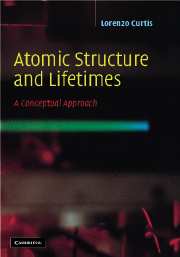Book contents
- Frontmatter
- Contents
- Preface
- List of physical constants and useful interrelations
- 1 Introduction
- 2 Semiclassical conceptual models
- 3 Semiempirical parametrization of energy-level data
- 4 The vector model of angular momentum
- 5 The intermediate coupling model
- 6 Electric dipole radiation
- 7 Line strengths in two-valence-electron systems
- 8 Magnetic dipole transitions
- 9 Absorption of radiation
- 10 Time-resolved measurements
- 11 Hyperfine structure
- 12 Electrostatic polarizabilities and long-range interactions
- 13 Coherence and anisotropic excitation
- References
- Index
10 - Time-resolved measurements
Published online by Cambridge University Press: 06 July 2010
- Frontmatter
- Contents
- Preface
- List of physical constants and useful interrelations
- 1 Introduction
- 2 Semiclassical conceptual models
- 3 Semiempirical parametrization of energy-level data
- 4 The vector model of angular momentum
- 5 The intermediate coupling model
- 6 Electric dipole radiation
- 7 Line strengths in two-valence-electron systems
- 8 Magnetic dipole transitions
- 9 Absorption of radiation
- 10 Time-resolved measurements
- 11 Hyperfine structure
- 12 Electrostatic polarizabilities and long-range interactions
- 13 Coherence and anisotropic excitation
- References
- Index
Summary
Time is that great gift of nature which prevents everything from happening at once.
–Clarence J. OverbeckThe key position played by the field of atomic physics in the development of modern quantum theory is owed in large part to the high precision with which the energy-level structure of the atom can be measured by the methods of high wavelength-resolution optical spectroscopy. Wavelength and frequency measurement accuracies that exceed parts in 108 are not only obtainable, but are required if the database is to be useful for diagnostic applications. By contrast, the measurement accuracies that can be obtained for other types of atomic structure properties is much lower. For lifetimes, transition probabilities, and oscillator strengths, extraordinary effort is required to achieve accuracies better than one percent. For cross section measurements, one must often be content with order-of-magnitude determinations, but the range of possible values makes reliable measurements to this accuracy valuable. While great strides have been made in ab initio theoretical methods, the attainable measurement accuracies for these quantities still exceeds the general reliability of calculations for cases involving complex many-electron atoms. Moreover, the accurate specification of wavelength and energy-level data does not ensure correct predictions of transition probabilities and lifetimes.
Measurements of lifetimes are particularly important, since they provide absolute rate values necessary to normalize relative transition probabilities obtained by time-integrated techniques. The availability of a comprehensive database for atomic transition probability rates has a significant impact on progress in other fields of science and technology, e.g., in fundamental physics and precise measurements; in the generation of coherent light; in atomic analysis in complex environments; in solar and astrophysics; and in plasma diagnostics.
Information
- Type
- Chapter
- Information
- Atomic Structure and LifetimesA Conceptual Approach, pp. 194 - 206Publisher: Cambridge University PressPrint publication year: 2003
